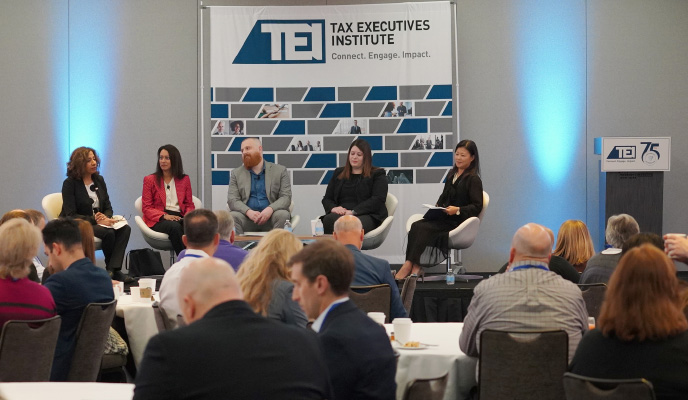In a particularly engaging session at TEI’s Annual Conference and 75th Anniversary Celebration, panelists discussed the dynamic developments that have resulted in what corporate tax professionals are calling “a new era in transparency.” The session included expert panelists: Sonal Majmudar, a tax partner at Mayer Brown; James Gordon, national co-lead for Deloitte’s tax governance and transparency practice; Jenna Summer, a partner in the accounting for income taxes group at KPMG’s Washington National Tax Practice, and Mimi Song, chief economist and general manager at Exactera and general manager at RoyaltyStat, an Exactera company. TEI International President Sandhya Edupuganty moderated the session.

The panelists discussed how the impetus for transparency got a boost following 2008’s financial crisis. After 2008, they noted, the Organisation for Economic Co-operation and Development (OECD) developed a global form of transparency and information exchange. More recently, there have been even more transparency-related requirements and refinements for tax forms and disclosures, the panelists said, citing the 2010 transfer pricing guidelines, the enactment of the Foreign Account Tax Compliance Act (FATCA) in 2012, and the OECD’s base erosion and profit-shifting (BEPS) initiative, which launched in 2015.
Majmudar pointed out that, today, companies face pressures, some unexpected, from many different directions. For example, she said, shareholder suits against some of the largest corporations in the United States are becoming more prevalent. Other sources of pressure, she noted, include media reports about effective tax rates (ETRs) and analysts who are asking about ETRs on investor calls. Just this summer, she said, the Senate Finance Committee increased its focus on the ETRs of pharmaceutical and life science companies by holding hearings on the issue.
Investors, Rate Reconciliation
Summer focused on the latest developments with Accounting Standards Update (ASU), which, she said, is close to being final, noting that a lot of feedback has come from investor inquiries. “Some comment letters on investor inquiries did specifically call out the fact that it was not the day-to-day investors that want this information but instead it was coming from activist investors,” Summer said.

On the issue of rate reconciliation, Summer noted that a significant amount of additional disaggregation is on the horizon. Under this disaggregation, there will be required categories, one of the biggest of which is “unrecognized tax benefits.” “They initially wanted that broken out by jurisdiction to the extent that it exceeded a specific threshold,” she said. “And the threshold will be the current SEC threshold of five percent of expected tax, which means to the extent that you’re reconciling to a twenty-one percent rate, any individual item that’s in excess of 1.05 percent will need to be on its own row in the rate reconciliation. The unrecognized tax benefits I thought was interesting. If you were to disclose some of that information by jurisdiction, it is providing an audit trail by jurisdiction, which is not ideal.
Edupuganty said she would not base her investment decisions on the tax rate or whether the rate reconciliation is by jurisdiction.
Even beyond income tax accounting, Gordon agreed that some investors had been less focused on demands for more transparency on tax. However, recent shareholder proxy votes on the topic, while not passing, may indicate that many investors are now wanting to see more. Beyond insight into tax risks, this tax information can also represent country-level commercial data, which could allow users to assess local country risks sooner if the data were available.
Song responded that the public has clearly been interested in tax positions. And members of the public themselves have boycotted, picketed, and called for greater taxation of certain companies, she noted.
Tax Governance
Song said that many companies are at the forefront of greater transparency now, informing the public through their 10-K filings. “There are companies out there that are now disclosing how much they pay in taxes and where. They’re writing more public statements,” she said.
Turning to Sarbanes-Oxley, Summer noted the evolution of SOX in the last twenty years, suggesting that tax departments are spending more time on auditing controls than on substantive work.
Gordon added that tax controls and governance are components of ESG too, and SOX is where a lot of it began. Well-known to those with operations overseas, there are already tax governance and control requirements in place in many countries around the world. The requirements in these regimes have been informing ESG frameworks, too, such as the Global Reporting Initiative’s GRI 207 tax standard.
Reputational Risk
Edupuganty discussed the responsibility of letting management know about reputational risks. “The thing with tax is, when we do well, it’s hard for people to see it. When we don’t do well, it is apparent to everybody. That’s the world we live in, navigating how best to project that we’re doing as well as we can given the constraints we have,” she explained.
“We’re moving into a transparent world of social media, of employees having views. People have feelings about tax. That didn’t happen in the past. People get passionate,” Gordon said.

Summer also discussed cubic reporting that will start to go public (A Cube is a data model that contains multiple dimensions (key reporting elements)). “This is a whole new world on the jurisdictional information, and I think it will be a little bit of a challenge in order to get it out there and provide that narrative. Because to the extent that something does pop, and you are disclosing it, you may want to consider that additional qualitative explanation in order to ensure that it’s not misconstrued and to ensure that you’re the ones setting that story and putting the story out there as to this background and this additional information that will be out in the market,” she explained.
“That’s absolutely one of the best responses you can have, to have a strategy around not only the quantitative but also the qualitative, so you can build a story around [them] and control the narrative. It’s very important,” Majmudar added.
“When I’m trying to inform some people on at least a best practice,” Summer said, “I would encourage them—maybe after ’23 financials are issued—to go back and redo the rate reconciliation under the new format. See what information you need. See where it’s at. I think one of the more challenging aspects is certain accounts may be recorded centrally. We’re going to need to bifurcate that, because it’s not going to be something that we can continue to maintain centrally and ensure is booked.”
Global Minimum Tax/Pillar Two
Majmudar turned to Pillar Two, which she noted is generally a global minimum tax that’s designed to ensure that all profit of an in-scope company is taxed at a rate of at least fifteen percent. Pillar Two generally applies to multinational enterprises that have revenue above $750 million, she noted. “It’s expected to generate approximately $150 billion in additional global tax revenue. Basically, the real issue is, with the four interlocking rules, who is going to get the first bite at the apple to tax the undertaxed profits.”
Turning her attention to the qualified domestic minimum top-up tax” (QDMTT), she said, “This came about since countries were not going to raise the rate. The QDMTT became the mechanism to be able to do that. Basically, a low-tax jurisdiction would enact it to make sure it is taxing at least fifteen percent. It starts with ‘qualified.’ So, certain standards apply, right? It has to fit within a certain construct of rules for it to be a qualified domestic minimum tax. And what has emerged is that the qualified domestic minimum tax is expected to be the primary tool,” she explained.
Majmudar then moved to the UTPR, which was originally called the “undertaxed payments rule.” “It’s evolved and is now being called the ‘undertaxed profits rule,’” she said. “It was originally designed as a backstop to that first rule, the IIR [income inclusion rule]. Basically, if a parent company is also going to forego that opportunity to tax, then other companies in the structure will have that right to tax. So, it was a backstop.” Another rule, the STTR—the subject-to-tax rule—was, she noted, “basically designed for developing countries to collect tax. And so, where does that leave us? How does that relate to country-by-country reporting? Well, there’s safe harbors for Pillar Two. For that safe harbor, you need a qualified financial statement. And in order for it to be qualified, you need to look at your country-by-country reporting [CbCR], and that’s where it becomes very important. So that’s the tie-in for the country-by-country and tax transparency.”
On the topic of achieving qualified CbCR reports, Gordon added some practical considerations. “There may be some basic hygiene going on around—e.g. pushing topsides down, purchase accounting, stock-based compensation, and other adjustments—so that your local-level CbCR numbers are supportable. As you’re doing that, including looking at your US GAAP versus local statutory financials, and broader reconciliations, it’s worth bearing in mind that, as early as next year, this data may also be public under the European Union CbCR rules.” There are differences in definitions across these regimes, as well as multiple variations and data sources. Companies should be prepared for questions from tax authorities, members of the public, and other stakeholders.
Majmudar added that it was important to begin early when it comes to the Pillar Two safe harbor provisions. “There’s a rule that if you’re once out, you’re always out,” she said. “And so, if you’re not doing it in the beginning, you’re not going to be able to access the transitional safe harbors in Pillar Two.”
Summer noted that, at least for US GAAP, there are no specific required disclosures on Pillar Two. “I think if there is material exposure, it’s probably prudent to disclose, but the [Financial Accounting Standards Board] noted that this is an AMT [alternative minimum tax],” she explained. “And so they said, ‘We’re going to follow the existing AMT guidance. We don’t need to disclose anything.’ I think for a lot of companies, you’re starting to see it trend more from risk factors into MD&A [management discussion and analysis] right now. And I think as we get into year-end ’23, we’re going to see a lot more MD&A, but I wouldn’t expect a whole lot to be called out even on the tax front unless you actually have material exposure. Then, from an IFRS [international financial reporting standards] standpoint, they actually took a little bit of a different approach because they don’t have AMT guidance under IAS 12. What they did is they issued an amendment in May to IAS 12, and they have a disclosure objective between the enactment date and the effective date of this guidance in order to provide guidance on how a company is analyzing and what kind of material risks they have. And then once it is effective, you will be required to disclose, under IFRS, the amount of the Pillar Two liability for that current period. But no deferreds; it actually makes, for once, the financial reporting aspect of it pretty straightforward.”
The session ended in a consensus statement, that when dealing with transparency issues, the key word for all corporate tax professionals was clear: communication.




